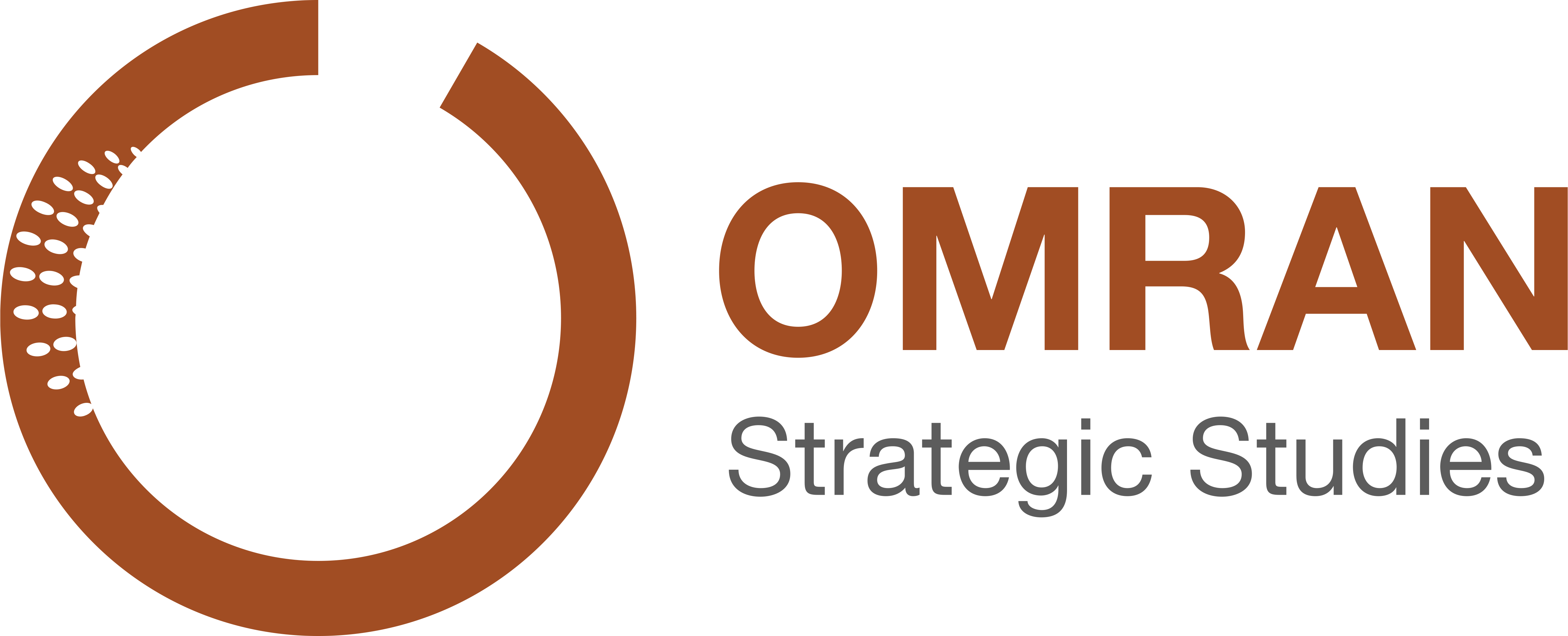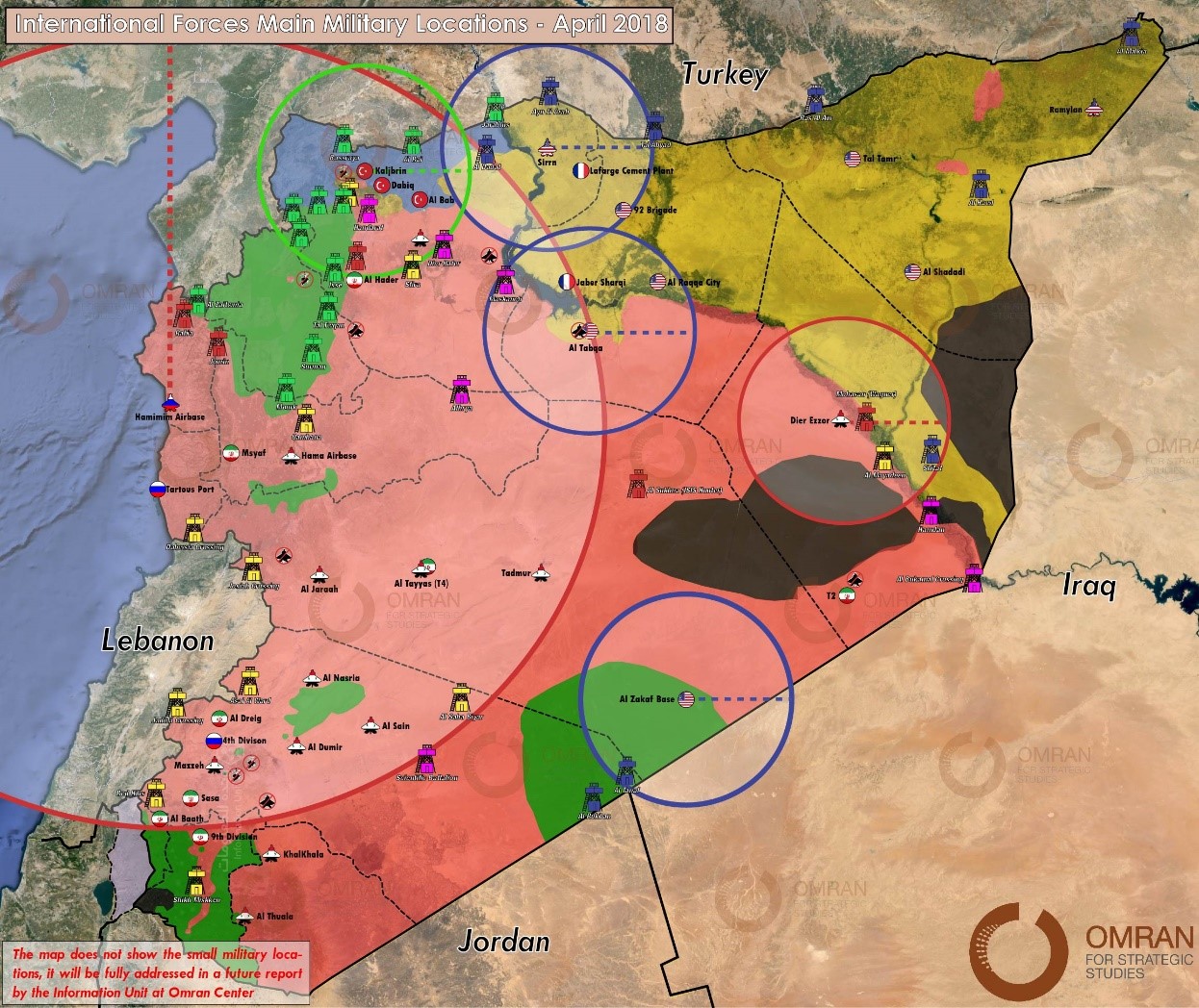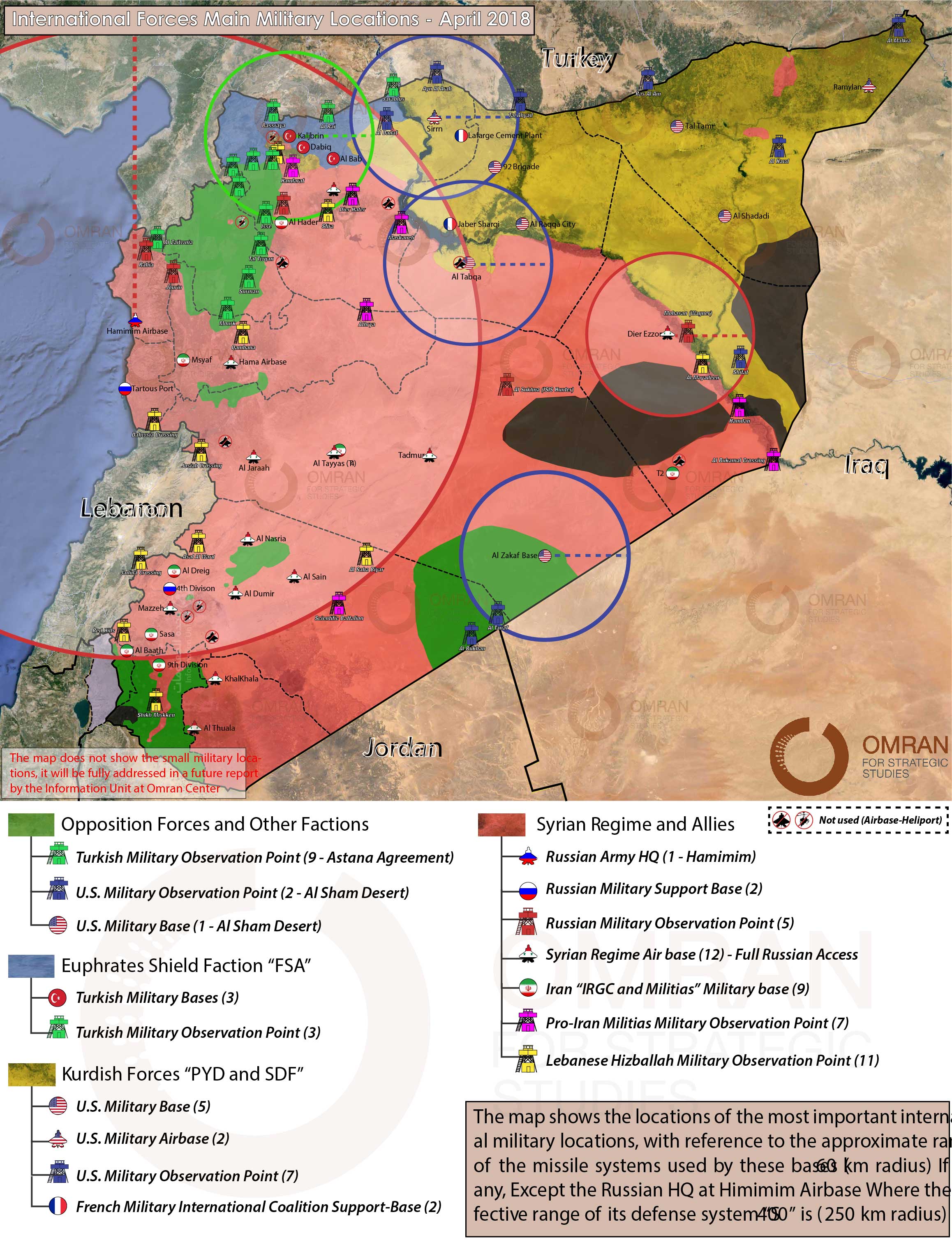Omran Center
Mr. Yaser Tabbara talking about Assad’s Idlib offensive
Mr. Yaser Tabbara talked about the Syrian regime troops, and their allies, had made major gains in Idlib province. Forces loyal to Bashar al Assad say they're targeting terrorists. But tens of thousands of people are fleeing towards the Turkish border, in what could create a new humanitarian disaster.
Annual Report 2017
Omran is an independent policy research center dedicated to the study of Syria and the surrounding region. Through our extensive network in Syria and Turkey, our team collects and analyzes direct data on the ground. We publish in-depth papers and reports on political, economic, and social issues in Syria and its regional and global impact. We also lead dozens of intensive workshops and roundtable discussions with scholars, lawmakers, and activists from Syria and beyond.
In 2017, we presented a number of research papers related to politics, security, local administration, and other prominent issues in Syria. Through our work, we remain focused on a paradigm of rebuilding state institutions from the bottom up in order to drive real change.
We have a lot more planned for 2018. We recently opened a new office in Washington, DC, and we expect to open new offices in Europe in the near future. Through these new offices, we will present a national vision for the Syrian cause through which the Syrian people will play a central role in building their future.
International Refugees Congress: Pursuing a Better Life for Refugees in Host Communities
Omran Center for Strategic Studies’ expert on economic development, Mr. Mohammed Al-Abdullah, participated in the International Refugee Congress in Istanbul, held on May 10-11, 2018. The conference was organized by Oxfam Turkey, and was the first attempt to submit a draft Global Compact on Refugees to the UN by civil society organizations concerned with refugees in all countries of the world. Draft proposals will be submitted to the United Nations High Commissioner for Refugees (UNHCR). The meeting brought together experts and civil society actors from around the world to develop policy briefs and help alleviate the burdens and responsibilities of refugees on host countries, and help with policy recommendations for integration of refugees in host markets and communities.
The Congress brought together a diverse group of civil society organizations concerned with refugee issues from several countries to participate in the drafting of a unified Compact to be submitted to the United Nations. The Congress was attended by prominent personalities related to refugee issues from United Nations organizations, international organizations, experts and academics. The conference included several group sessions to discuss among participants and to contribute effectively to highlight priorities from the perspective of refugees.
Additionally, participants were split into smaller groups for specialized mini-panels to focus more on the sub-themes of the conference in order to allow participants to present their ideas and proposals. The panels focused on six key themes: durable solutions and shared responsibility, access to services, legal rights of refugees, women and displacement, representation and participation. At the conclusion of the conference, a joint document was prepared, which included the proposals and recommendations of the participants in these workshops. The conference was attended by 130 participants from 27 countries.
Iranian Economic, Administrative, and Military Influence in Syria 2017
This report is an introduction for a series of reports, which will address Iran's military and economic activities in Syria during 2018.
The current report highlights Iran's most prominent activities in 2017, activities that still have major effects until this date.
Introduction
Iranian influence in Syria is often reduced to its military support, including more than 50,000 armed militia members.([1]) Iran's Islamic Revolutionary Guard Corps (IRGC) and its auxiliary institutions not only provided military and financial support to the Syrian regime but have expanded their administrative and economic activities in Syria by infusing their institutions within the Armed Forces, service-delivery ministries, local political and armed bodies, and non-governmental organizations. This monitoring report provides an overview of Iran’s illicit activities in Syria during 2017 and early 2018. It provides indicators for its long-term interests and highlights mechanisms that it uses to infiltrate government agencies, the private sector, and society in general regardless of the political outcome of the crisis.
1. Iran’s Military Presence and Strategies
IRGC forces organize their operations in Syria according to five main military fronts:
- Damascus: includes the governorates of Damascus and its suburbs.
- Southern: includes the provinces of Daraa, Quneitra, and Suwayda.
- Central: includes the governorates of Homs, Hama, and Idlib.
- Coastal: includes the provinces of Lattakia and Tartus.
- Northern: includes the governorates of Aleppo and Raqqah.
In addition, the IRGC established military bases in all of the aforementioned fronts to accommodate up to 10,000 fighters who report directly to IRGC command, such as Al-Fatemiyoun, Al-Zaynibion, and Quds Brigade. It supplied these bases with heavy weapons and anti-aircraft missiles. The central headquarters or command center used by Iranian forces is located in a building at Damascus Airport called the "Glass House," where Syrian forces are barred from entering. This has allowed Iranian forces and their bases to receive and store arms and military equipment from Iran without being checked or monitored. Foreign fighters, Foreign fighters, such as those from Lebanon, Iraq, Afghanistan, and Palestine, are not subject to the orders of Syrian generals in the Syrian Army. They are under the command of the IRGC.
1.1 Recruitment Processes
The recruitment process of Iranian-backed foreign fighters primarily targets individuals from the Shiite sect. The rise of Iraqi Shiite militias in Syria became more visible since the emergence of Abu Fadl al-Abbas Brigade at Sayeda Zeinab district in Damascus in 2012. The recruitment of Iraqi Shiite jihads took place mainly at mosques and Shiite seminaries under the patronage of Shiite clerics. Later, recruitment shifted to social media. Iran also recruited Afghan refugees from among the estimated three million Shiites of Hazara; less than a million of them held official refugee status in Iran. Others are forced to volunteer to fight in Syria under threat of deportation to Afghanistan.
Although the majority of Pakistan’s population is Sunni, there are several million Shiites who are the target for IRGC recruitment campaigns. Others volunteer to carry arms and die in defense of the Shiite community, the majority of whom are Pashtun from the Parachinar region of Pakistan tribal districts.
Recruitment campaigns are carried out at Shiite holy sites in Iraq, Iran, Lebanon, and Pakistan, in addition to other supplemental online campaigns through social media. Campaign messages tend to focus on the pretext of defending Shiite holy sites and the Shia community. Military training is provided for approximately two months and sometimes for up to six months for heavy weapons training programs.
1.2 Iranian Deployment of Fighters into Syria
- Lebanese Hezbollah: Hezbollah positions in Lebanon close to the border with Syria, as well as positions along the border inside Syria, allowed for around 15,000 fighters to travel back and forth between Lebanon and Syria. The supply routes between Lebanon and Syria have not been cut off despite the duration of the war.
- Iraqi Shiite Militias: Initially, Shiite fighters traveled with their vehicles and military equipment from the Iraq-Syria border crossing when the regime controlled these crossings. However, when the border crossings with Iraq were seized by opposition forces, and later by ISIS, Iraqi Shiite fighters had to travel by air from Al Najaf International Airport in Iraq to Damascus International Airport. Militia members traveled on Iran Air and Cham Wings Airlines, owned by Rami Makhlouf.
- Afghani and Pakistani Shiite Militias: After receiving training at Iranian camps, these militias were transported via Tehran Airport to Damascus International Airport. In some cases, they were transferred by ground transportation networks from Iran to Iraq using the Shalamjah border crossing. After entering Iraq, they were sent to their final destination of Damascus via Najaf Airport.
1.3 Iran’s Military Activities during 2017
1.3.1 Forming and funding Brigade 313 as "Part of the Syrian Army"
Iran has continued its encroachment into southern Syria despite international agreements aimed at curbing its role in the area and despite the latest Russian-American de-escalation agreement signed in November 2017.
Because of their security interests in southern Syria, Israel, Jordan, and the US regard the expansion of Iranian militias near the border with Jordan and with the Israeli-occupied Golan Heights as “a red line,” and thus they require swift military action. Despite this “red line,” Iran has continued to push the limits and expand its presence in recent months.
The province of Daraa witnessed an unexpected increase in conscription campaigns between Iranian and Regime forces during October and November 2017. The IRGC formed Brigade 313 as a new force in Daraa province and targeted young men for recruitment. Within a short period, the Iranian-led 313 Brigade attracted more than 200 young men. Members who were conscripted into the formation were mostly young men from Daraa known to work on behalf of the regime. They were promoting the force because of the salaries and benefits it provides. Enlisting in the army militias takes place at the Brigade 313 headquarters in the city of Izra. New members receive an ID badge with the IRGC logo, ensuring his ability to pass through regime-force checkpoints. Two weeks after joining, recruits were enrolled in training camps in Izra and Sheikh Maskin.
1.3.2 Establishing Al-Kiswah, a new military base in Damascus
The Iranian military established a compound at a site used by the Syrian army outside Al-Kiswah, 14 km (8 miles) south of Damascus. The base lies about 50 km (31 miles) from the Israeli-occupied Golan Heights.
Satellite images show construction activity at the site referenced by the intelligence source between January and October 2017.

Images expose a series of two dozen large low-rise buildings, likely used for housing soldiers and vehicles.
In recent months, additional buildings were added to the site. However, it is impossible to independently verify the purpose of the site and the presence of the Iranian military.
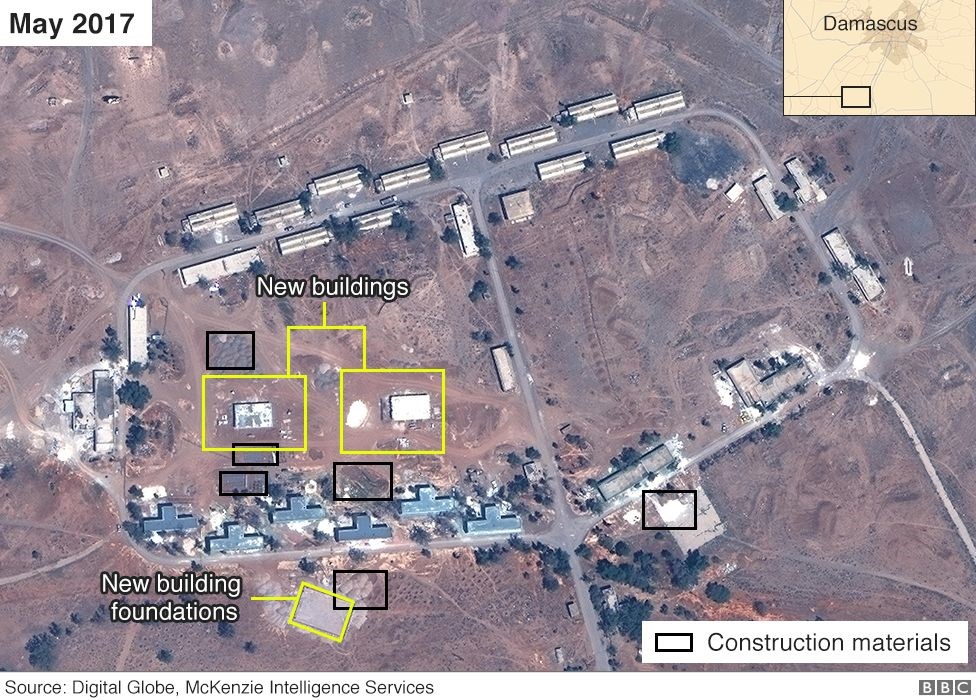
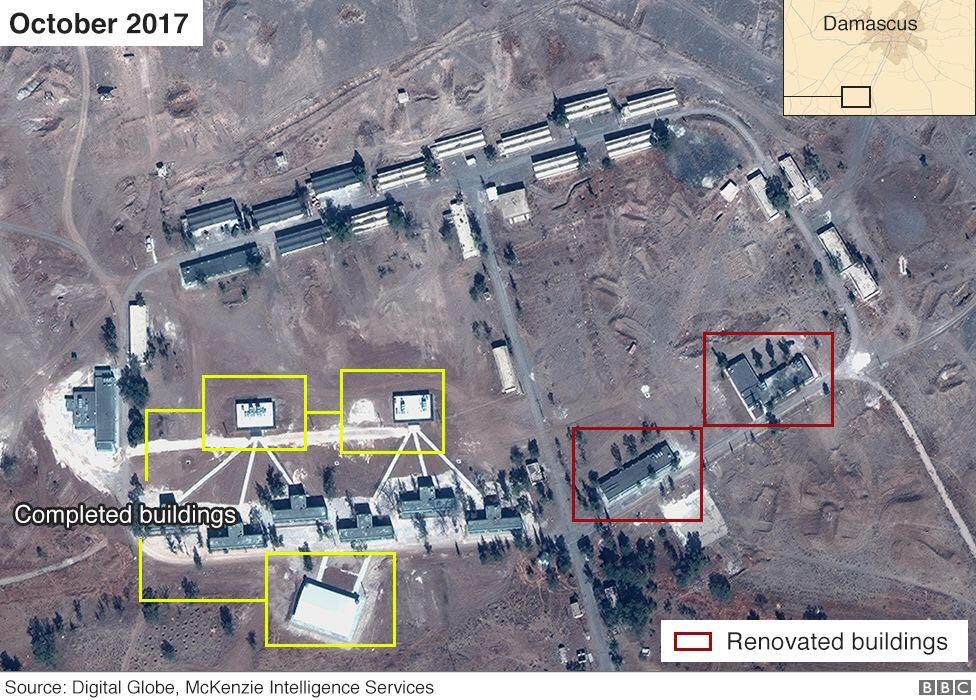
The images of the base do not reveal any signs of large or unconventional weaponry, which means if it were a base, it would most likely be to house soldiers and vehicles. Private sources indicate that senior Iranian military officials may have visited the compound in recent weeks. The images suggest that the facility is military in nature with several garages that can hold six to eight vehicles each.
New buildings were constructed and other buildings renovated in the past six months, although the exact use of the new structures cannot be determined. It is also not clear whether the facility is currently occupied. Shia fighters from other countries, including Pakistan and Afghanistan, are also alleged to be operating in Syria under the control of the IRGC, and it is possible they could use the base.
From the number of buildings and the size of the base, the estimated number of troops deployed there is around 500.
1.3.3 Iraqi Popular Mobilization Units (PMU) in Al-Bukamal
- Badr Organization
Established in 2003 by the Badr Brigades, this faction is the paramilitary organization of the Islamic Supreme Council of Iraq (ISCI), a Shia Islamist party. Its leader is Hadi Al Amiri. At present, it is not only a military organization but also a political party with 22 seats in the Iraqi parliament. Its military units comprise 10,000-15,000 trained fighters. Its units were spotted in every PMU operation against ISIS.
In Syria, they participated in battles in southern Aleppo and Western Qalmoun. Currently, they are based in southern Aleppo.
- Kata’ib Hezbollah (Battalions of the Party of God)
This organization was formed in 2003 as a resistance movement against the US invasion of Iraq. It is led by Abu Mahdi al-Muhandis and has up to 30,000 troops. Its fighters also support regime forces in Syria.
- Kataib Al Imam Ali (Imam Ali Battalions)
This is an armed wing of the Iraqi Islamic Movement that was formed in June 2014 in response to ISIS aggression. It is led by Shibl al Zayd who earlier fought in the Mahdi Army under the leadership of Moqtada al-Sadr. This group stands out because its membership draws from the Christian group the Spirit of God Jesus Son of Mary Battalions. Its units participated in operations to recapture Palmyra, in battles for Tikrit, and in the siege of Mosul.
- Harakat Hezbollah Al Nujaba (Movement of the Party of God’s Nobles)
It was formed in 2013 in response to the war in Syria after a dispute with the leadership of Asaib ahl al Haq. The two groups still maintain close ties and often cooperate on the battlefield. It is led by Sheikh Akram al Kaabi, whose ideology is consistent with that of Ayatollah Khamenei.
1.3.4 Other military activities and developments involving Iran
- 16 June 2017: The IRGC fired six surface-to-surface mid-range ballistic missiles from a base near the Iranian-Iraqi border against ISIS forces in Deir ez-Zor province. The strike was in response to ISIS-led terrorist attacks in Tehran earlier that month.
- 23 November 2017: The IRGC Commander Ali Jafari promised to provide the "best weapons" to Hezbollah: (([2]))
[He] confirmed that the Lebanese Shia movement Hezbollah, which is actively fighting ISIS in Syria, would be equipped with the best weaponry despite the circumstances, “Hezbollah needs to remain armed in order to fight Israel, Lebanon’s enemy. Naturally, they need to be equipped with the best weapons in order to protect Lebanon’s security—this matter is non-negotiable,” he stated. Jafari also added that Tehran would put substantial effort into the ceasefire to end the war in Syria.
- 27 November 2017: Afghan officials declared their opposition to the involvement of any Afghan fighters under the command of Quds Force in the Fatemiyoun division and PMU in Syria and Iraq. (([3]))
Abdullah Abdullah, Head Chief of Afghanistan’s National Unity Government, said on Monday, November 27, at a meeting of the Council of Ministers in Kabul, “The Afghan government's policy of fighting Daesh (ISIS) is clear. We do not support the presence and participation of Afghans in the war in any country. Hussein Mortazavi, the administrator of the Afghan presidential representative, said: “We are opposed to any proxy war in other countries.”
- 27 November 2017: The chief commander of the IRGC confirmed that the Global Islamic Basij(([4])) are present in Syria and Iraq, with smaller cells deployed in other countries around the world. He threatened that soon the world would witness the impact of this global Basij.(([5]))
1.3.5 Iran forces and allies killed in action (KIA) in the 4th quarter of 2017
| October 2017 | |||
| KIA Faction | # | KIA Nationality | # |
| Hezbollah | 33 | Lebanon | 7 |
| FatemiyounBrigade | 1 | Iraq | 1 |
| ImamAli Brigade | 1 | Syria | 33 |
| SyrianIslamic Resistance | 7 | Iran | 2 |
| IRGC | 2 | Afghanistan | 1 |
| Total KIA | 45 | ||
| November 2017 | |||
| KIA Faction | # | KIA Nationality | # |
| IRGC | 6 | Iraq | 2 |
| FatemiyounBrigade | 5 | Syria | 10 |
| Saraya Al Areen | 4 | Iran | 6 |
| Imam Al Baqir Brigade | 7 | Afghanistan | 5 |
| Al Abaas Forces | 1 | Pakistan | 2 |
| Hezbollah | 4 | Lebanon | 4 |
| ZaynibionBrigade | 2 | ||
| Total KIA | 29 | ||
| December 2017 | |||
| KIA Faction | # | KIA Nationality | # |
| IRGC | 6 | Iraq | 4 |
| FatemiyounBrigade | 4 | Syria | 3 |
| Saraya Al Areen | 1 | Iran | 6 |
| Hezbollah | 14 | Afghanistan | 4 |
| Saraya Al Khursani | 2 | Lebanon | 12 |
| Sayda Zinab Brigade | 8 | Palestine Basij | 9 |
| Al Quds Brigade | 1 | ||
| Al-Imam Hussein Brigade | 2 | ||
| Total KIA | 38 | ||
2. Major Iranian Economic Activities and Projects
2.1 Economic activities timeline in 2017
- 12 June 2017: The Syrian regime’s Ministry of Electricity signed a memorandum of understanding with the Iranian Reconstruction Authority to establish a power station to feed the towns of Nubl and Zahraa in the countryside of Aleppo.
- 8 October 2017: The Local Defense Forces’ (LDF) camera monitors the distribution of humanitarian aid provided by Iran in Rasm Al-Abd, east of Aleppo, where the Al-Thaqlin Center supervised and distributed aid to the people. Video: https://goo.gl/8SEh8w
- 9 October 2017: The Iranian Reconstruction Authority affiliated with the LDF rehabilitated Ibn Hazm School of Andalusia in the Saladin district in the city of Aleppo. Video:https://goo.gl/S1ZKZ5
- 9 October 2017: The Iranian Reconstruction Authority affiliated with the LDF rehabilitated Fadil School in the town of Nubl in northern Aleppo. Video: https://goo.gl/kLVaAn
- 9 October 2017: The Iranian Reconstruction Authority affiliated with the LDF rehabilitated Ali Abdo School in the town of Zahraa in northern Aleppo. Video: https://goo.gl/E9x4nY
- 13 October 2017: The Iranian Reconstruction Authority affiliated with the LDF rehabilitated Ibn Hazm School of Andalusia in the Saladin district in the city of Aleppo. Video: https://goo.gl/S1ZKZ5
- 13 October 2017: The Iranian Reconstruction Authority affiliated with the LDF rehabilitated Fadil School in the town of Nubl in northern Aleppo. video: https://goo.gl/kLVaAn
- 13 October 2017: The Iranian Reconstruction Authority affiliated with the LDF rehabilitated Ali Abdo School in the town of Zahraa in northern Aleppo. Video: https://goo.gl/E9x4nY
2.2 Iranian-backed Jihad Al-Benna Organization: Major Activities
- 28 October 2017: The Jihad Al-Benna Organization implemented reconstruction and recovery projects in the countryside of Aleppo.https://goo.gl/FJuAeb
- 8 November 2017: The Jihad Al-Benna Organization implemented reconstruction and recovery projects. https://goo.gl/EkgD7H
- 23 November 2017: Jihad Al-Benna Organization delivered much-needed humanitarian aid to the residents of Al Bukamal after several days of fighting ISIS near the city.
- 3 December 2017: Fourteen schools in the eastern districts and villages of Aleppo and 10 schools in the towns of Nubl and Al Zahraa were constructed by the Iranian-backed Jihad Al-Benna Organization in Syria. Video: https://goo.gl/cM8i3X
- 14 December 2017: The inauguration of a new hospital in Aleppo by the LDF at an LDF facility in cooperation with Jihad Al-Benna.
- 16 December 2017: The LDF seems primarily geared towards outreach efforts everything, from rubble clearing to blood drives, sporting events, city beautification projects, and children's camps in Aleppo.
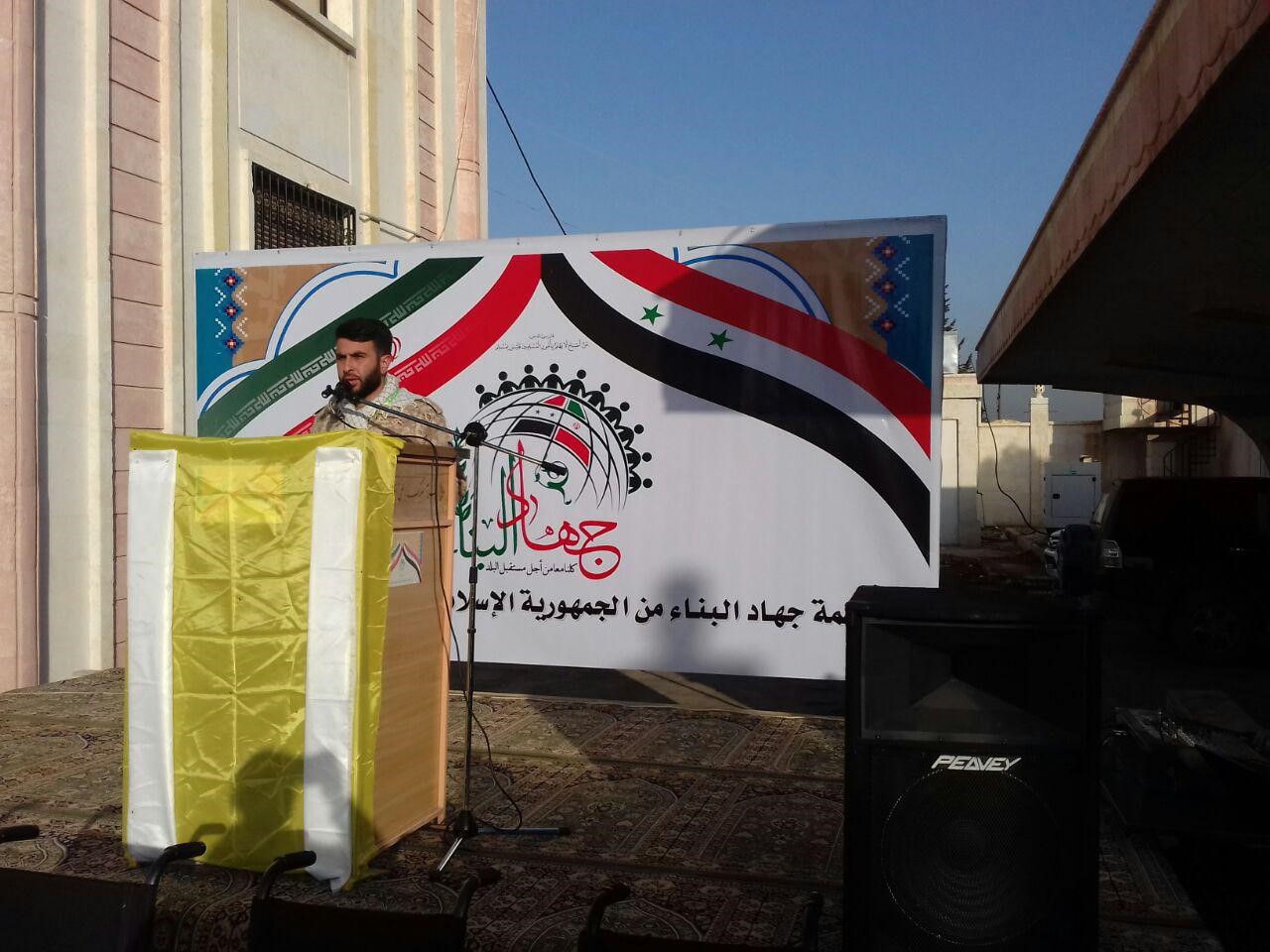
Representatives from Iran attended the ceremony and also Aleppo government and several of military leaders from SAA.
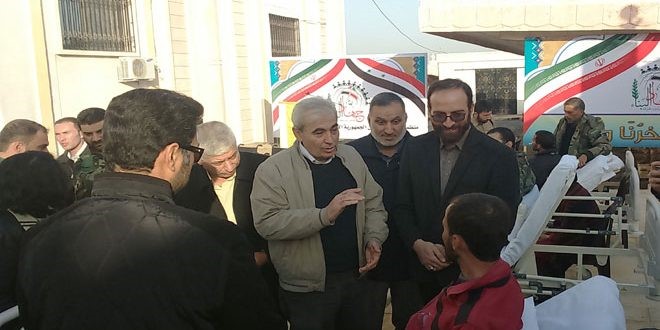
Dr. Ahmed Abadi al-Husseini, director of the Islamic Jihad Organization of Iran, said that the honor of the wounded and wounded from the Syrian Arab Army and the allied forces is "a thank-you gesture, pointing out that the Islamic Jihad Organization of Islamic Jihad continued to pay attention to wounded and sick.
2.3 Establishing a New University in the City of Aleppo
Iran and Syria signed a memorandum of understanding to establish a branch of Islamic Azad University in the city of Aleppo. A deputy head of Iran’s Islamic Azad University, Saleh Eskandari said, “Syrian President Bashar Assad has welcomed the plan to establish a branch of Islamic Azad University (IAU) in Syria.” Assad has called on the related officials, including the board of directors of Iran’s IAU, as well as the Iranian Embassy in Damascus, to pave the way for the establishment of the university after ensuring legal arrangements with the Syrian Ministry For science, he added. Outlining the details of the MoU in a Farsi interview with Fars News Agency, Eskandari also noted that the MoU was signed at a ceremony attended by Ali Akbar Velayati, an advisor to Iran’s leader, who was visiting Aleppo to lead a delegation.
2.4 Reactivate the Triangular Electrical Line between Iran, Iraq, and Syria
A joint meeting of the Syrian, Iraqi, and Iranian electricity ministries was held at the Iranian Ministry of Energy in Tehran to sign a protocol to reactivate the tripartite electricity link between the three countries. The first line will be connected to 400 kV / 155 km, of which 25 km from Al Qaim station to the Iraqi-Syrian border, 130 km in Syrian territory up to Al Taym station and the second line 230 KV 42 km through the Syrian Swedish stations and Tel Abu Zaher.
- 4 December 2017: Russian and Iranian parliamentarians met to discuss infrastructure projects in Syria.
The Chairman of the Russian State Duma Committee for International Affairs, Leonid Slutsky, announced today (Monday) December 4 that the committees of the Duma and the Iranian parliament would meet to discuss the reconstruction in Syria.
According to "Sputnik" Russian, Slotsky pointed out that the parliamentarians gathered to discuss the activities of "Shiite police" in areas where there is a population of the Shiite community, as he put it.
Iran's Supreme Leader Ali Akbar Velayati, who visited Aleppo last month, stressed his country's readiness to participate in the reconstruction of Syria.
The Minister of Public Works and Housing in the Syrian regime, Hossein Arnous, announced large cooperation agreements between Syria and Iran in several areas, notably reconstruction.
- 6 December 2017: The Syrian Minister of Finance said that no one is hungry in Syria and that he is sometimes hungry because "he does not have time to eat."
- 7 December 2017: The price of the Iranian rial dropped significantly against the dollar from the average price of 4093 during the month of November to a record level of 4230.
- 8 December 2017: The Syrian Parliament approved an amendment raising the reconstruction tax from 5 percent to 10 percent.
- 9 December 2017: The Central Bank in Syria reversed a month-old decision to put limits on remittances/transfers of money into the country.
- 12 December 2017: The Associated Press obtained a copy of a 48-page contract between Evro Polis and Syria’s state-owned General Petroleum Corp., which said the Russian company would receive 25 percent of the proceeds from oil and gas production at fields its contractors capture and secure from ISIS militants.
- 14 December 2017: The opening of a new hospital in Aleppo by the LDF at an LDF facility in cooperation with Jihad al-Benna.
3. Military Appendix
3.1 Maps and Infographics
Map (1) International Main Military Bases and Airports - April 2018
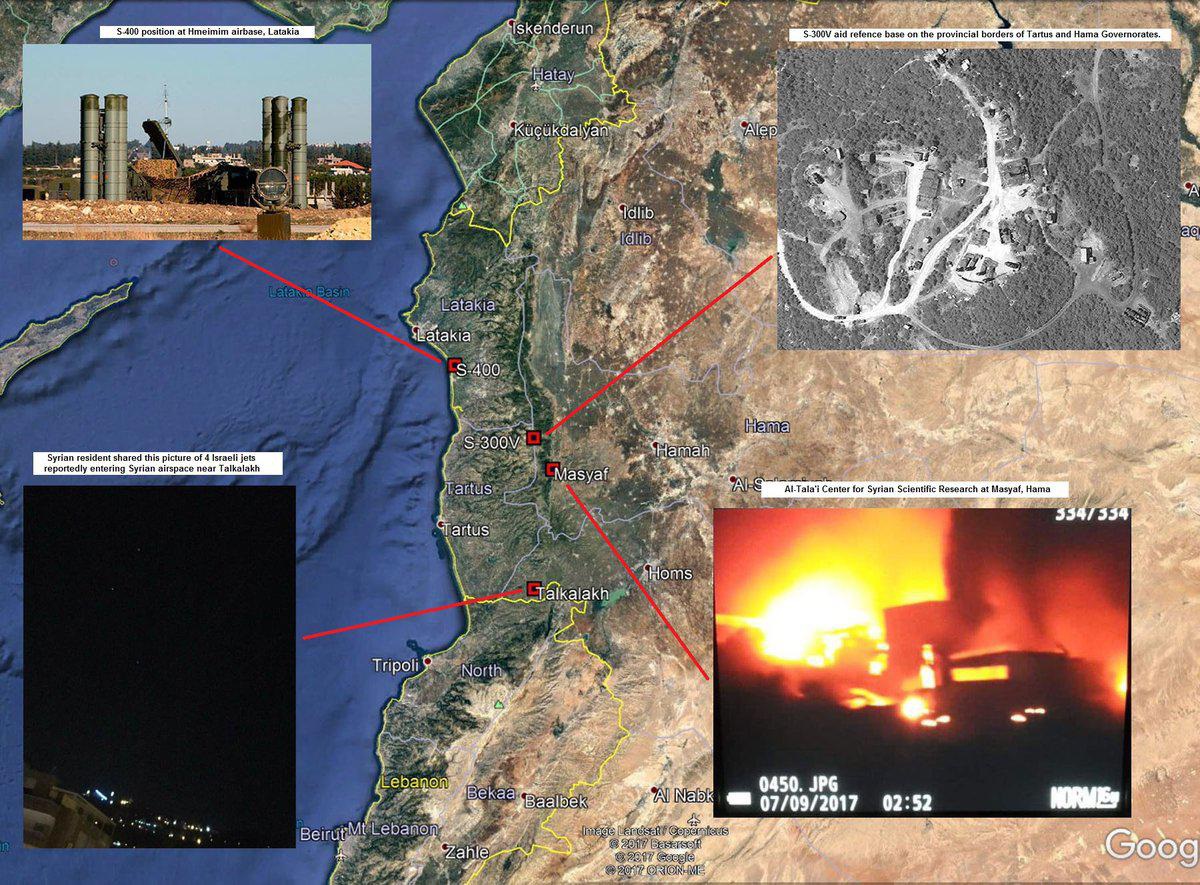
The Scientific Research Center in the city of Musayaf was targeted by an Israeli air strike on 7 September 2017. The entry of Israeli aircraft was from Lebanon over Telaklakh, and the Russian S300 system was only 15 km away from the target area and 60 km from the point where the aircraft entered.
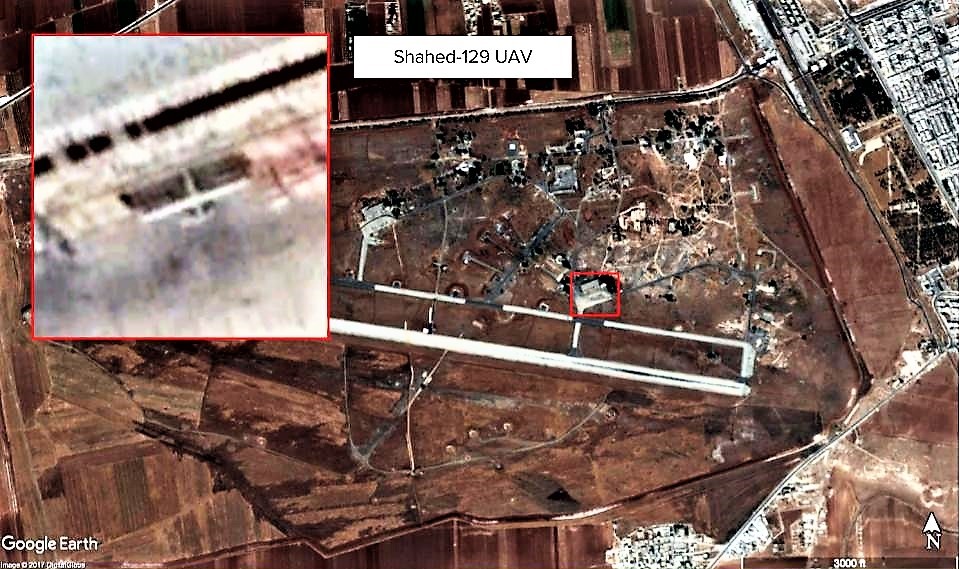
Iranian Shahed-129 drone at Hama airbase in Syria on 9 October 2017.
On the same day, the city of Khan Sheikhoun in Idlib was hit by a drone strike. An inside source confirmed that the Iranian drone took off before the hit in 30m.
3.2 Videos of Iran and Its Militias Military Involvement
- 8 November 2017 - Full video released by Hezbollah media shows scale of IRGC group deployment across Iraq-Syria border - https://goo.gl/SVrtX1
- 9 November 2017 - Hezbollah armor and vehicle columns outside of Bukamal - https://goo.gl/kqWX9x
- 18 November 2017 - Shia militia encampments and artillery positions outside Bukamal - https://goo.gl/rvPXc5
- 18 November 2017 - Intense combat between Hezbollah forces and ISIS in Bukamal - https://goo.gl/465Vsw
- 19 November 2017 - Hezbollah media releases video of Qassem Soleimani outside headquarters in Bukamal; claims he led the entire battle - https://goo.gl/kJuQCy
- 23 November 2017 - IRGC and PMU forces at Al Sa'ah Square in Al Bukamal - https://goo.gl/11Nhjb
- 25 November 2017 - 313 Battalion Commander Al Hajj Abu Abbas - https://goo.gl/NUyWna
- 28 November 2017 - Video for the IRGC-sponsored Afghan militia Liwa Fatemiyoun and Pakistani militia Liwa Zainebiyoun, southeast of Deir Ez-zor - https://goo.gl/P7FTJ2
- 29 November 2017 - Iraqi Bell 407 and Mi-35M monitoring the border between Al Qaim and Al Bukamal - https://goo.gl/nsjPEo
- 2 December 2017 - Al Nujaba Movement (Harakat Al Nujaba, PMU and Militias active in Syria) release footage of its recent battles in Al Bukamal City - https://goo.gl/fzHFAj
- 2 December 2017 - Video showing medical team of pro-Iran militias and Iraqi PMU Katiba Imam Ali treating civilians in Abu Kemal - https://goo.gl/564rTp
- 5 December 2017 - Saraya Al Areen forces are in Deir Ez-Zor to support SAA and Allied Forces - https://goo.gl/564rTp
- 6 December 2017 - According to the pro-opposition TV Channel Jisr, 400 Hezbollah militiamen have reached Baath City in Quneitra and taken positions in government buildings and several military positions in the area- https://goo.gl/wY5FXo
- 7 December 2017 - Video of Hezbollah and allies operation against ISIS in Shayir and Ghabrah in Eastern Deir ez-Zor - https://goo.gl/WwDmBP
- 7 December 2017 – Pro-Iran militias lead attack on the western countryside of Al Bukamal https://goo.gl/564rTp
([1]) The Number is a result of analyzing Footage and Videos of these groups along with information from private sources.
([4])Basij is a voluntary militia organization established in Iran in November 1979 by Ayatollah Khomeini. The official name is Besic Resistance Force. Basij is now a subordinate of the Iranian Revolutionary Guards
Nawar Oliver talking to The Daily Star about the Americans strike and how Iran is a big target of it
On the 14th of April 2018 (The Daily Star) published "Gemma Fox" recent article entitled "Strike a chance for ‘dissed’ Trump to hit back", in the article Nawar oliver Omran Center Military Expert mentioned, he Addressed the possible American strike on Syrian Regime military Site and how Iran military presence might be one of the major targets of American's strike:
- The Strike would not be about chemical weapons but rather “an excuse” to target Iran, which the country’s leaders have wanted to do for some time.
- Iran now has at least nine key military bases and seven observation posts throughout Syria – an indication of Tehran’s growing influence in the country.
- An attack on an Iranian target, may therefore satisfy the need for a response while not necessarily upsetting Russia to the point of military retaliation, even though angry public statements will be inevitable.
- Such a strike, for the U.S., U.K. and France, means “they can hit two birds with one stone,” he said, striking Russia and Iran while “showing to the world that they care.”
*Important Note: The Article was published before the U.S., U.K. and France strike in Syria.
Original Link: https://goo.gl/zJTKBy
Nawar Oliver contributed on an article entitled "Expert Views: Impact of the Syrian Missile Strike"
Omran Center Military Expert Nawar Oliver contributed on an article entitled "Expert Views: Impact of the Syrian Missile Strike" published on Syria Deeply, Oliver Sid " In my perspective, do you think the Americans, British and French really care about the regime and that the [attack] yesterday was just to prevent the use of chemical weapons? It was part of it. But the main thing is, there was a hidden message to the Russians that despite your existence and massive victories on the ground, we remain part of the game and we will always be part of the political solution".
for More Click here: https://goo.gl/hhmLeb
International Main Military Bases and Airports- April 2018
Future of peace and stability in Syria
Omran for Strategic Studies led a panel discussion in Washington, DC on 20 March 2018. The panel in partnership with the American Relief Coalition for Syria, brought together experts from inspiring Syrian humanitarian and research organizations to discuss the current situation in Syria and prospects for a future of peace and stability. Thank you to Karam Foundation, Syrian American Medical Society- SAMS, and Oxfam America for your participation.
US in a Post-ISIS Iraq and Syria:Realigning Allies and Constraining Adversaries
On March 26, Hudson Institute hosted a panel to explore U.S. options to realign our allies with traditional NATO and U.S. positions, hold adversaries responsible for atrocities, and prevent security backsliding in the region.
The panel consisted of Hudson Institute Senior Fellow Hillel Fradkin; Hudson Adjunct Fellow Michael Pregent; Senior Intelligence Planner at the Institute for the Study of War Jennifer Cafarella; Co-Founder and Executive Director of the Omran Center for Strategic Studies Ammar Kahf; and President of Soran University Dr. Nahro Zagros.
The Military Expert Nawar Oliver talking about the Syrian regime cut up Ghouta into three zones
Nawar Oliver at Omran for strategic Studies, said in his last interview with AFP, "The Syrian regime cut up Ghouta into three zones, to comfortably work on securing three different agreements, and the Syrian regime is justifying this brutal campaign in order to secure the capital, which is regularly battered by rockets and mortars fired from the opposition territory as the regime claim.
Published in AFP Agency, 15 March.2018,
